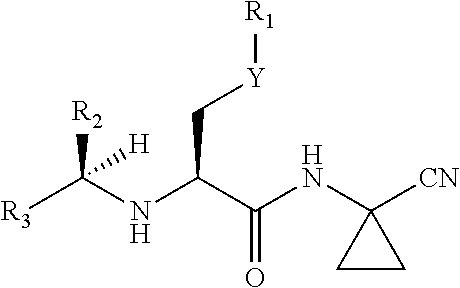Cathepsin inhibitors for treating microglia-mediated neuron loss in the central nervous system
a technology of cathepsin inhibitors and neuron loss, applied in the direction of biocide, cardiovascular disorder, drug composition, etc., can solve the problems of pathological consequences, aberrant activity of cysteine proteases, etc., and achieve the effect of reducing microglia-mediated neuro-inflammation and preventing or reducing microglia-mediated neuronal loss
- Summary
- Abstract
- Description
- Claims
- Application Information
AI Technical Summary
Benefits of technology
Problems solved by technology
Method used
Image
Examples
synthetic example 2
Synthesis of N-(1-cyanocyclopropyl)-2(R)-[2,2,2-trifluoro-1(S)-(2,4-difluoro-phenyl)ethyl-amino]-3-(cyclopropylmethylsulfonyl)propionamide (compound 43)
[0101]
Step 1
[0102]2,4-Difluorobenzaldehyde (1.1 mL, 10.0 mmol) and (trifluoromethyl)trimethylsilane (1.77 mL, 12.0 mmol) were dissolved in THF (25 mL) and then cooled to 0° C. To this, 1M TBAF in THF (76 μL, 76 μmol) was added and the reaction mixture was allowed to warm to room temperature. After 3.25 h, 2.5M HCl (25 mL) was added. The reaction was stirred for 1 h and then extracted with ether. The organic layer was washed with brine and dried with Na2SO4. The solvent was removed under the reduced pressure to give 2,2,2-trifluoro-1-(2,4-difluoro-phenyl)ethanol (2.5 g) as a racemic mixture.
Step 2
[0103]2,2,2-Trifluoro-1-(2,4-difluorophenyl)ethanol (1.36 g, 6.4 mmol) was dissolved in dichloromethane (25 mL) and diisopropylethylamine (DIPEA, 5 mL, 28.8 mmol) was added. The resulting solution was cooled to −78° C. and trifluoromethanesul...
synthetic example 3
Synthesis of N-(1-cyanocyclopropyl)-3-(cyclopropylmethanesulfonyl)2(R)-[2,2,3,3,3-pentafluoro-1(S)-(4-fluorophenyl)propylamino]propionamide
[0125]
Step 1
[0126]To a solution of 1-bromo-4-fluorobenzene (16.5 mL, 0.15 mol) in anhydrous THF (200 mL) at −78° C., was treated with n-BuLi (60 mL; 150 mmol; 2.5 M in hexane) and the solution was stirred for 1 h. 2,2,3,3,3-pentafluoropropionic acid ethyl ester (14.4 g, 75 mmol; 50 mol %) was added neat added neat. After stirring for 4.5 h at −78° C., ethyl ether and sat. solution of NH4Cl were added. The layers were separated and the aqueous phase extracted with ethyl ether. The combined organic layers were washed with brine, and dried over sodium sulfate. The solution was concentrated on a rotavap and the residue was purified by distillation to give 2,2,3,3,3-pentafluoro-1-(4-fluorophenyl)propan-1-one (13.1 g; 71%).
Step 2
[0127]To a solution of 2,2,3,3,3-pentafluoro-1-(4-fluorophenyl)propan-1-one (13.0 g, 53 mmol) in a mixture 1:1 of dichloromet...
synthetic example 4
[0134]
Scheme 5, Step 1
(S)-4,4-difluoro-5-phenyl-2-((S)-2,2,2-trifluoro-1-(4-fluorophenyl)ethylamino)pentanoic acid
[0135]
[0136]Methyl (S)-methyl 2-amino-4,4-difluoro-5-phenylpentanoate HBr salt (2.44 mmol, 1 eq.) was dissolved in dry methanol. Trifluoromethyl 4-fluorophenyl ketone (2.44 mmol, 1 eq.) and potassium carbonate (4.88 mmol, 2 eq.) were added, and the mixture was heated at 50° C. overnight. To the resulting condensation (imine-formation) reaction product was added, at −30° C., a suspension of Zn(BH4)2 (ca. 1.1 eq.) [which was prepared from NaBH4 (1 eq.) and ZnCl2 (1M in diethyl ether; 2 eq.)], and the mixture was allowed to warm to RT overnight. The reaction was quenched with 1 N HCl and extracted with ethyl acetate, dried and concentrated to give the crude product, (S)-4,4-difluoro-5-phenyl-2-((S)-2,2,2-trifluoro-1-(4-fluorophenyl)ethylamino)pentanoic acid.
Scheme 5, Step 2
(S)—N-(1-cyanocyclopropyl)-4,4-difluoro-5-phenyl-2-((S)-2,2,2-trifluoro-1-(4-fluorophenyl)ethylamino)p...
PUM
 Login to View More
Login to View More Abstract
Description
Claims
Application Information
 Login to View More
Login to View More - R&D
- Intellectual Property
- Life Sciences
- Materials
- Tech Scout
- Unparalleled Data Quality
- Higher Quality Content
- 60% Fewer Hallucinations
Browse by: Latest US Patents, China's latest patents, Technical Efficacy Thesaurus, Application Domain, Technology Topic, Popular Technical Reports.
© 2025 PatSnap. All rights reserved.Legal|Privacy policy|Modern Slavery Act Transparency Statement|Sitemap|About US| Contact US: help@patsnap.com



